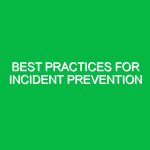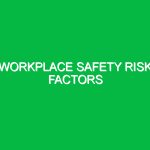Introduction
In today’s fast-paced business environment, large enterprises face a multitude of challenges, not least of which is ensuring the health, safety, and environmental (HSE) welfare of their workforce. Safety Management Systems (SMS) for large enterprises are critical frameworks that help organizations systematically manage safety risks, comply with regulatory requirements, and foster a culture of safety. By integrating various processes, procedures, and practices, these systems not only protect employees but also enhance operational efficiency and corporate reputation.
The relevance of Safety Management Systems in the HSE domain cannot be overstated. They serve as a structural foundation for identifying, assessing, and mitigating risks associated with workplace hazards. In essence, these systems are about creating a safe working environment where employees feel valued and secure. This article delves into the various aspects of Safety Management Systems for large enterprises, including the identification of hazards, risk assessment, safety precautions, and relevant regulations.
Understanding Safety Management Systems
At its core, a Safety Management System is a cohesive set of elements and processes designed to manage safety risks and improve safety performance. For large enterprises, this complexity increases due to the scale of operations, diverse workforce, and varied regulatory requirements. An effective SMS typically includes components such as policy formulation, risk assessment, performance monitoring, and continuous improvement.
Key Components of a Safety Management System
An SMS comprises several key elements:
- Safety Policy: A clear statement outlining the organization’s commitment to safety.
- Risk Assessment: Procedures for identifying and evaluating risks associated with workplace activities.
- Training and Competence: Ensuring employees have the necessary skills and knowledge to perform their jobs safely.
- Incident Reporting and Investigation: Mechanisms for reporting safety incidents and learning from them.
- Performance Monitoring: Regular assessments to gauge the effectiveness of safety measures.
- Continuous Improvement: Processes for making ongoing enhancements to the SMS based on feedback and data.
Identifying Hazards and Risks
Large enterprises often operate in environments rife with potential hazards. These can be broadly categorized into physical, chemical, biological, ergonomic, and psychosocial risks. Each category presents unique challenges that require tailored risk management strategies.
1. Physical Hazards
Physical hazards include machinery, equipment, and environmental conditions that can cause injury or harm. For example, in a manufacturing plant, workers may be exposed to moving parts, noise, or slips and falls. Implementing machine guards, conducting regular safety audits, and ensuring proper housekeeping practices can significantly mitigate these risks.
2. Chemical Hazards
Exposure to hazardous substances, such as solvents or acids, poses significant risks. Large enterprises must maintain Material Safety Data Sheets (MSDS) for all chemicals, conduct training on safe handling practices, and ensure proper storage to minimize exposure.
3. Biological Hazards
In industries like healthcare or agriculture, employees may encounter biological agents such as bacteria or viruses. Effective control measures include vaccination programs, personal protective equipment (PPE), and robust hygiene practices.
4. Ergonomic Hazards
Poor ergonomics can lead to musculoskeletal disorders. Large enterprises should conduct ergonomic assessments, encourage proper lifting techniques, and provide adjustable workstations to reduce these risks.
5. Psychosocial Hazards
Work-related stress and harassment are critical concerns. Promoting mental health awareness, providing support services, and fostering a positive workplace culture are essential for mitigating psychosocial risks.
Safety Precautions and Best Practices
Once hazards are identified, implementing safety precautions is paramount. Here are some actionable best practices for large enterprises:
1. Establish a Safety Culture
Creating an organizational culture that prioritizes safety is fundamental. Leadership should actively promote safety initiatives, involve employees in safety discussions, and reward safe practices. For instance, a large construction firm might host regular safety meetings where workers can share their experiences and suggestions.
2. Conduct Regular Training
Ongoing training is critical for ensuring that employees are aware of risks and equipped to manage them. Whether it’s through workshops, online courses, or hands-on training sessions, regular education helps reinforce safety protocols. A manufacturing company might implement a monthly refresher course on machine safety to keep knowledge fresh.
3. Implement Emergency Preparedness Plans
Every large enterprise should have a well-defined emergency response plan. This plan should outline procedures for various scenarios, such as fires, chemical spills, or natural disasters. Regular drills and simulations can ensure that employees know how to react in emergencies.
4. Utilize Technology
Advancements in technology provide numerous tools to enhance safety management. From incident reporting apps to real-time monitoring systems, leveraging technology can streamline safety processes. For example, a logistics company might use GPS tracking to monitor driver behavior and reduce the risk of accidents.
5. Regularly Review and Update Policies
Safety regulations and workplace conditions evolve. Therefore, it is crucial for large enterprises to periodically review and update safety policies to reflect current standards and practices. This could involve conducting annual audits or engaging third-party safety consultants for an objective assessment.
Regulations and Standards Governing Safety Management Systems
Large enterprises must navigate a complex web of regulations and standards governing safety management. Compliance not only ensures legal adherence but also enhances organizational reputation. Key regulations include:
1. Occupational Safety and Health Administration (OSHA)
In the United States, OSHA sets forth regulations to ensure safe working conditions. Compliance requires large enterprises to adhere to standards related to hazard communication, personal protective equipment, and recordkeeping.
2. ISO 45001
This international standard specifies requirements for an occupational health and safety (OH&S) management system, helping organizations improve employee safety and reduce workplace risks.
3. Environmental Protection Agency (EPA)
The EPA regulates environmental hazards, requiring large enterprises to manage waste, emissions, and hazardous materials responsibly.
4. Industry-Specific Standards
Depending on the industry, additional regulations may apply. For instance, the construction sector must comply with specific safety standards set forth by the National Institute for Occupational Safety and Health (NIOSH).
Conclusion
Safety Management Systems for large enterprises are not just a regulatory requirement; they are a vital component of sustainable business operations. By systematically identifying hazards, implementing best practices, and adhering to relevant regulations, organizations can create a safer workplace that prioritizes employee well-being and enhances overall productivity. In a world where safety is paramount, investing in an effective SMS is not merely an obligation but a strategic advantage that can lead to long-term success.


